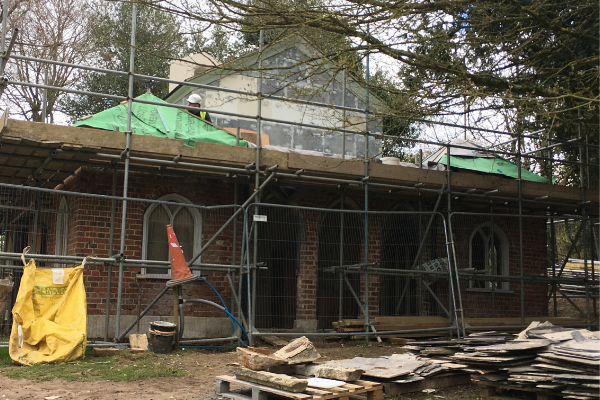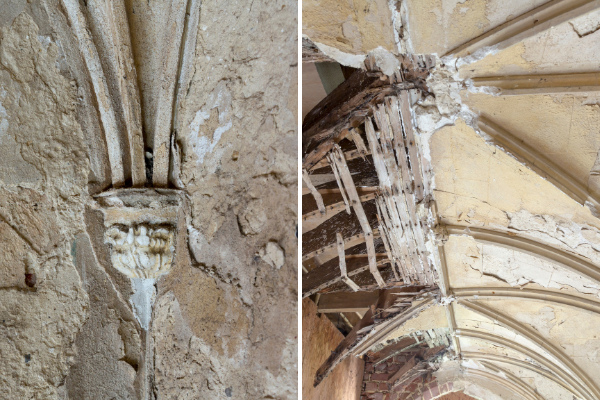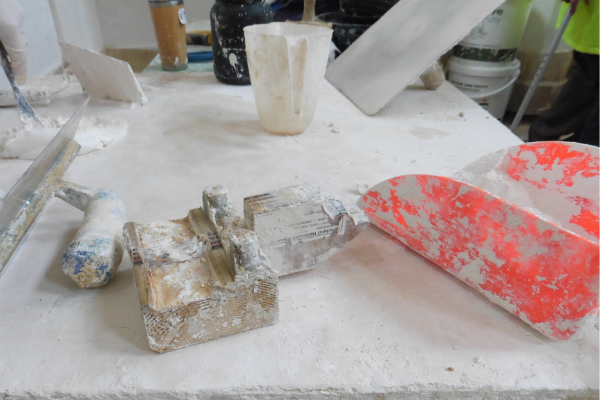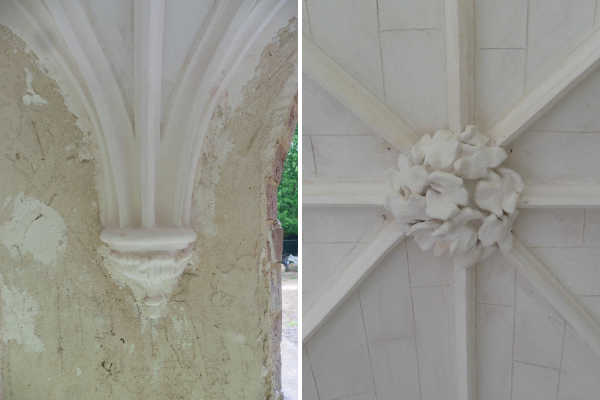
It is now June 2019 and the re-plastering of the Dairy at Cobham Hall is advancing apace. We know that the Italian plasterer, Francisco Bernasconi, was working for James Wyatt at Cobham Hall in the very early years of the 19th century – and as Wyatt is the Dairy’s architect, it seems plausible that it was Bernasconi who created the delicate ribbed and vaulted plasterwork for the Dairy, which was built at the end of the 18th century.

Time has not been kind to this original work. The plasterwork to the North cloister and to the main double-height chamber had been entirely lost by the mid-1980s. In the West and South cloisters, much of the inner half remained but the outer sections had rotted and fallen away. (The East wing was the Dairymaid’s accommodation – her bedroom and scullery, and she didn’t get any decorative plaster ceilings!)

Luckily, a number of original Wyatt drawings for the Dairy survive, dated 1794/5. They are at the Yale Centre for British Art, New Haven, Connecticut, and several of these show the intended plasterwork – including a reflected ceiling plan showing the layout of the ribs; and details for the sections of the ribs and the corbels from which they spring on the walls.
We knew that recreating all this missing plasterwork would require skill and craftsmanship of the highest order. Rather being pre-cast from a mould in a workshop, the ribs would originally have been run ‘in situ’ - which is enough of a skill when running straight cornices, but of course, the ribs are all curved, which is an added challenge. The project team drew up a shortlist of plastering contractors that we knew had the requisite skills to carry out such work. The tendering contractors were allowed to choose whoever they wanted from this shortlist.
We were delighted that Colmans were the successful tenderer following their careful restoration of another Landmark, St Edward’s Presbytery, in Ramsgate – they chose Philip Gaches as their sub-contractor. Philip is well-known in the plastering world and is a true ‘time-served’ craftsman having trained under his father who established the business back in 1948. Now recognised by his peers as a ‘Master’ plasterer, Philip has been working at the Dairy with his two sons, Will and Jude, and Anna Castilla Villa, who first spent time with Philip gaining work experience as a Prince’s Foundation Apprentice. As Philip says – “she’s never really left!”.
So how do you re-create curved ribbed plasterwork? First of all you need the timber formwork to provide the structure and basic shape. Because so much of this had been lost, most of it has been newly made by Colman’s joinery sub-contractor, delivered in sections, and erected by the Colmans team on site. They discovered that the replacement roof over the main chamber had been rebuilt (not to its historic form) a few inches lower than the original. And so the formwork all had to be adjusted so that it would sit at the correct height so that the new ribs would line up with the few remnants of the original that were on the walls.

This formwork is then covered in timber laths. Philip’s team have taken over from Colmans for this stage onwards, and they have used split chestnut laths. Other materials typically used are oak and pine, although the latter is sawn rather than split – and weaker as a result. Along the line of the ribs, stainless steel screws are inserted but left sticking out and along them garden twine is threaded to act as additional key for the new ribs just as was done originally (except with iron nails).
The next stage is to form the ribs. To do this, ‘running guide’ timbers are set up on the curve below the line of where the ribs will run on top of the laths. The plaster is made up using traditional slaked lime putty mixed with sharp sand in a 1:3 mix and gauged with some gypsum plaster to give a faster set. The plaster is pushed through the gaps between the laths to form a ‘nib’ at the rear – which effectively acts as a hook keying the plaster and all subsequent coats to the laths. On the larger ribs in the main chamber, these first coats are shaped to the correct profile using a ‘muffle’ which is a zinc template of the reverse of the profile of the rib, which is some 5mm short of the final finish. Layers of lime plaster are applied and then the muffle, mounted onto a timber running mould, is run along the running guides to create a rib close to the final profile.

To create the exact, smooth and crisp final finish, the muffle is changed to another template which is the exact finished profile of the rib. (For the smaller cloister ribs, the final template is used throughout). Again, the mould is run along the greased running guides a number of times, each time adding more plaster to any missing areas to ensure that the exact finish is created.
The above processes create most of the ribs – but where multiple ribs spring from a wall corbel, or meet at the centre of the ceiling, there isn’t room for the running mould to fit, and so all these ends of the ribs have to be created by hand, modelling the exact same shape in situ, so that when finished it all looks the same.
The final operations are to create the corbels, from which the ribs spring on the wall surface - and also the bosses, which sit over the intersection of the ribs where they meet on the ceiling centre line. The corbels are cast and then they have decorative ‘enrichments’ applied to them to give them their final appearance. These enrichments are cast in plaster moulds and then fitted to the curved shape of the corbel whilst they are still pliable. Any final modelling is done by hand.
Wyatt’s drawings are rather sketchy when it comes to the detail of the bosses. So Philip and his team, and in particular Anna, have used some of the Wyatt bosses in Cobham Hall as inspiration, whilst also bringing their own creativity to the finished designs. Again, the bosses are not pre-cast, but entirely modelled by hand in situ. And if you look carefully, you may spot a scallop shell or two, which is Philip’s own personal ‘signature’.

At the time of writing, the main chamber, which for over 35 years had just been a shell, now has its glorious plaster ceiling recreated, and using exactly the same skill, care and craftsmanship that was used back in the 18th century. The smooth areas of plaster are all ‘lined out’ to resemble ashlar stonework (ie to create the look of fine joints between blocks of stone), and there will finally be a coat of sandy paint, as used on the external slate cladding, and all to enhance the impression that you are inside a stone vaulted building.
None of this extensive and complex work would have been possible without your generous support, and that of Ecclesiastical Insurance, for the restoration of Cobham Dairy. Our sincere thanks – once again – from all the team at Landmark.
